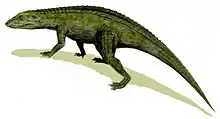Paratypothorax
Paratypothorax is an extinct genus of aetosaur, known by one species, Paratypothorax andressi. It was first named in 1985 from specimens collected from the Lower Stubensandstein in Germany and was also noted to be present in the Chinle Group of the southwestern United States in both the Dockum and Chinle Formations, which are latest Carnian and Rhaetian in age, respectively.[1][2] The genus was described from osteoderms that were initially referred to the phytosaur Belodon kappfi.[3] Material from Paratypothorax has also been reported from the Norian-age Fleming Fjord Formation in Greenland.[4]

| Paratypothorax | |
|---|---|
 | |
| Scientific classification | |
| Kingdom: | Animalia |
| Phylum: | Chordata |
| Class: | Reptilia |
| Order: | †Aetosauria |
| Family: | †Stagonolepididae |
| Tribe: | †Paratypothoracisini |
| Genus: | †Paratypothorax Long and Ballew, 1985 |
| Species | |
| |
Paratypothorax possesses paramedian scutes that are wide, strap-like, and have grooves and pits on them forming radial patterns. Like other typothoracisines such as Typothorax, the lateral scutes bear large horns that are posteriorly hooked.[5] The rear of each scute is overlapped by a prominent knob.[6]
References
- Long, R. A.; Ballew, K. L. (1985). "Aetosaur dermal armor from the Late Triassic of southwestern North America, with special reference to material from the Chinle Formation of Petrified Forest National Park". Museum of Northern Arizona Bulletin. 47: 45–68.
- Hunt, A. P.; Lucas, S. G. (1992). "The first occurrence of the aetosaur Paratypothorax andressi (Reptilia:Aetosauria) in the western United States and its biochronological significance". Paläontologische Zeitschrift. 66 (1–2): 147–157. doi:10.1007/BF02989485.
- Parrish, J. M. (1994). "Cranial osteology of Longosuchus meadei and the phylogeny and distribution of the Aetosauria". Journal of Vertebrate Paleontology. 14 (2): 196–209. doi:10.1080/02724634.1994.10011552.
- Jenkins, F. A. Jr.; Shubin, N. H.; Amaral, W. W.; Gatesy, S. M.; Schaff, C. R.; Clemmensen, L. B.; Downs, W. R.; Davidson, A. R.; Bonde, N.; Osbaeck, F. (1994). "Late Triassic continental vertebrates and depositional environments of the Fleming Fjord Formation, Jameson Land, East Greenland". Meddelelser Om Grønland, Geoscience. 32: 1–25.
- Murry, P. A. (1986). "Vertebrate paleontology of the Dockum Group". In K. Padian (ed.). The Beginning of the Age of Dinosaurs. Cambridge: Cambridge University Press. pp. 109–138.
- Heckert, A. B.; Lucas, S. G. (1999). "A new aetosaur (Reptilia: Archosauria) from the Upper Triassic of Texas and the phylogeny of aetosaurs". Journal of Vertebrate Paleontology. 19 (1): 50–68. CiteSeerX 10.1.1.563.9516. doi:10.1080/02724634.1999.10011122.

